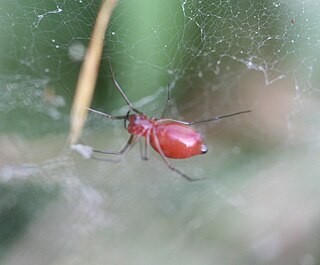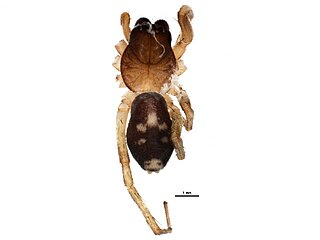 W
WActinopus is a genus of mygalomorph spiders in the family Actinopodidae found in South America, Central America, and Trinidad. It was erected in 1883 by Maximilian Perty from the type species Actinopus tarsalis found in Brazil. The name is derived from Greek actin- "ray, beam" and pous "foot".
 W
WAgobardus is a genus of jumping spiders that was first described by Eugen von Keyserling in 1885.
 W
WAnasaitis is a genus of jumping spiders that was first described by E. B. Bryant in 1950. The name is derived from the salticid genus Saitis.
 W
WThe Antilles pinktoe tarantula, also known as the Martinique red tree spider or the Martinique pinktoe is popular as a spider pet because of its docile character and unique coloration.
 W
WAvicularia avicularia, sometimes called the pinktoe tarantula, is a species of tarantula native from Costa Rica to Brazil and the southern Caribbean. This species is sometimes called the Guyana pinktoe, common pinktoe, or South American pinktoe.
 W
WFlorinda, commonly called black-tailed red sheetweaver or red grass spider, is a monotypic genus of dwarf spiders containing the single species, Florinda coccinea. It was first described by Octavius Pickard-Cambridge in 1896, and has only been found in Mexico, the West Indies, and the United States. It is common in the southeastern United States, inhabiting grasslands, lawns, and agricultural fields.
 W
WCaribena is a genus of spiders in the family Theraphosidae (tarantulas), found in the Antilles. The two species accepted as of March 2017 were formerly placed in Avicularia. Apart from a different distribution – Avicularia species are found in mainland South and Central America – Caribena is distinguished by having longer and thinner type II urticating hairs in a conspicuous patch on the upper surface of the abdomen. Males also have a differently shaped palpal bulb.
 W
WCaribena laeta is a species of spider in the family Theraphosidae, found in the US Virgin Islands, Puerto Rico, and Cuba, the last dubiously according to Caroline Fukushima and Rogério Bertani in 2017.
 W
WCeraticelus is a genus of dwarf spiders that was first described by Eugène Louis Simon in 1884.
 W
WCraspedisia is a genus of comb-footed spiders that was first described by Eugène Louis Simon in 1894. As of May 2020 it contains three species, found in China, the Dominican Republic, and Brazil: C. cornuta, C. longioembolia, and C. spatulata.
 W
WCubanops is a genus of Caribbean araneomorph spiders in the family Caponiidae first described by A. Sánchez-Ruiz, Norman I. Platnick & N. Dupérré in 2010. These spiders are wandering hunters, generally found at ground level, under stones, in leaf litter or in the soil, and have only been found in the West Indies.
 W
WEnoploctenus is a genus of wandering spiders first described by Eugène Simon in 1897.
 W
WFalconina is a genus of corinnid sac spiders first described by Paolo Brignoli in 1985.
 W
WHabronattus mexicanus is a jumping spider species in the genus Habronattus. It is the type species of that genus.
 W
WHolothele is a genus of tarantulas that was first described by Ferdinand Anton Franz Karsch in 1879. Originally placed with the curtain-web spiders, it was transferred to the tarantulas in 1980.
 W
WJollas is a genus of jumping spiders (Salticidae), found in Central America, the Caribbean and South America.
 W
WMarpissa pikei is a species of jumping spider that is found in the eastern United States, Texas, New Mexico, Arizona and Cuba.
 W
WNeoholothele incei is a species of tarantula from Trinidad and Venezuela, commonly called the Trinidad olive tarantula. When mature, the species has a leg-span exceeding 5–7.5 cm (2.0–3.0 in). As often the case with tarantulas, the females live longer than males, with the former living up to 7 years compared to the 2 years that males can expect to reach. N. incei is a bird spider and is fossorial. It is commonly kept as a pet as it is easy to breed. Rarely for tarantulas, N. incei is known to live communally and cannibalism is rare except for times of extreme hunger. Like most New World species, the venom of N. incei is considered to be mild and comparable to a bee sting, however no research has confirmed this.
 W
WNops is a genus of medium-sized South American, Central American, and Caribbean spiders in the family Caponiidae, first described by Alexander Macleay in 1839. It has a great richness on the Caribbean islands, and most mainland species are located in high proportion toward the Caribbean coast. It likely has a neotropical distribution, though most species of South America are known only from the coast of Colombia and Venezuela, including the islands of Aruba, Curaçao, Bonaire and Trinidad.
 W
WMedium-sized caponiids with only two eyes and carapace uniformly orange. N. guanabacoae is the type species of genus Nops, more information on this article.
 W
WOchyrocera is a genus of midget ground weavers that was first described by Eugène Louis Simon in 1892.
 W
WOgulnius is a genus of ray spiders that was first described by Octavius Pickard-Cambridge in 1882.
 W
WPhormictopus is a genus of spiders in the family Theraphosidae (tarantulas) that occurs in the West Indies, mainly Cuba and Hispaniola, with three species probably misplaced in this genus found in Brazil and Argentina.
 W
WPhormictopus cancerides, also known as the Hispaniolan giant tarantula, is a tarantula endemic to Hispaniola in the Caribbean.
 W
WPsalmopoeus cambridgei, the Trinidad chevron tarantula, is a species of spider in the family Theraphosidae, endemic to Trinidad. Its venom is the source of psalmotoxin and vanillotoxin which are classified as inhibitor cystine knot proteins. Psalmotoxin may be of therapeutic use in patients suffering from a stroke.
 W
WPseudhapalopus is a monotypic genus of Bolivian tarantulas containing the single species, Pseudhapalopus aculeatus. It was first described by Embrik Strand in 1907, and is found in Bolivia.
 W
WTetrablemma is a widespread genus of armored spiders first described by Octavius Pickard-Cambridge in 1873. It only has four eyes; an unusual trait for spiders, found only here and in some species of Caponiidae, though the two are not closely related. The eyes are large, but unequal in size, closely grouped around the center of the prosoma that rises in a somewhat of a cone shape from the abdomen. They have four closely positioned spinnerets enclosed in a corneous casing.
 W
WZygoballus concolor is a species of jumping spider which occurs in Cuba. It was first described by the arachnologist Elizabeth B. Bryant in 1940.